DESIGN PROCESS OF NOEME 1.0 & NOEME 2.0
The design development of the two soft wearable designs were guided by the Somaesthetic Design Framework, reflecting on:
(1) Felt-Experiences of self-regulation for stress and relaxation,
(2) Poetics of Breathing and Body Movement,
(3) Materials for Relaxation Responses,
(4) Kinetic Feedback that supports Self-Regulation for Relaxation and Stress-release
(1) Felt-Experiences of self-regulation for stress and relaxation,
(2) Poetics of Breathing and Body Movement,
(3) Materials for Relaxation Responses,
(4) Kinetic Feedback that supports Self-Regulation for Relaxation and Stress-release

Material and Conceptual Sketches for the two wearable designs.
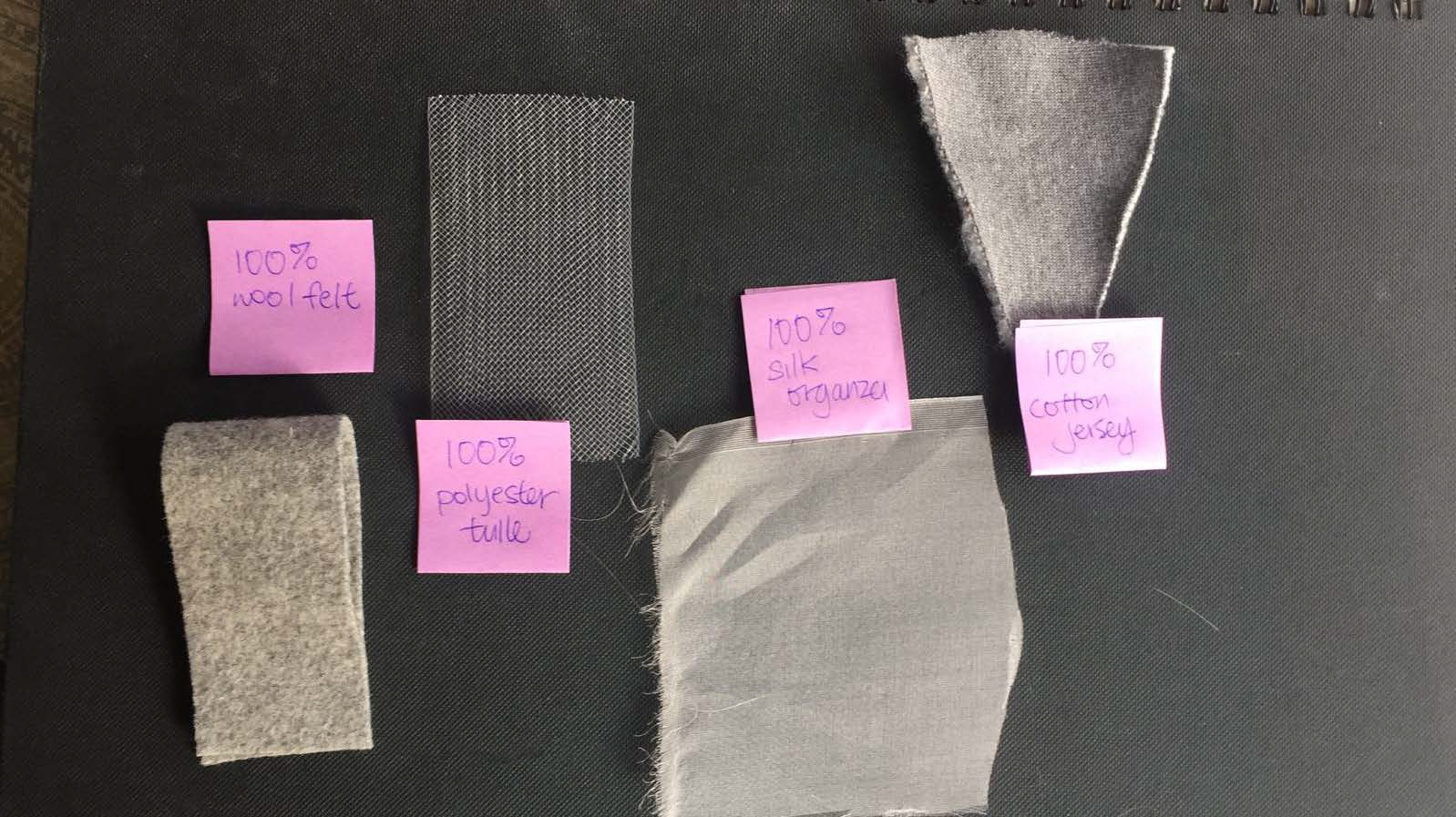
Swatches of Wool Felt, Polyster Tulle, Silk Organza, Cotton Jersey
For the design of Noeme 1.0, the design mapped the leaf-like, elongated shapes that are light-weight in density around the chest.
With an up-and-out compression and expansion, the design represented the engagement of intercostal muscles around the ribcage to facilitate the process of inhaling and exhaling air.
I used grey wool felt with the crinoline horsehair.
For the front design of Noeme 2.0, the design utilized a cluster of rotund, organic shapes that are soft, light-weight in density in the centre chest, loosely forming an abstracted outline of lungs.
The silk-organza puffs, with a radial compression and expansion, also represented the alveoli, signifying an exchange of oxygen and carbon dioxide, or the process of breathing.
For the back design of Noeme 2.0, the design placed the leaf-like elongated shapes that are light-weight in density in an inverted triangle on the upper back.
With a directional compression and expansion, the horsetail shapes represent the muscles tensing and releasing, resulting in changes of one’s posture.
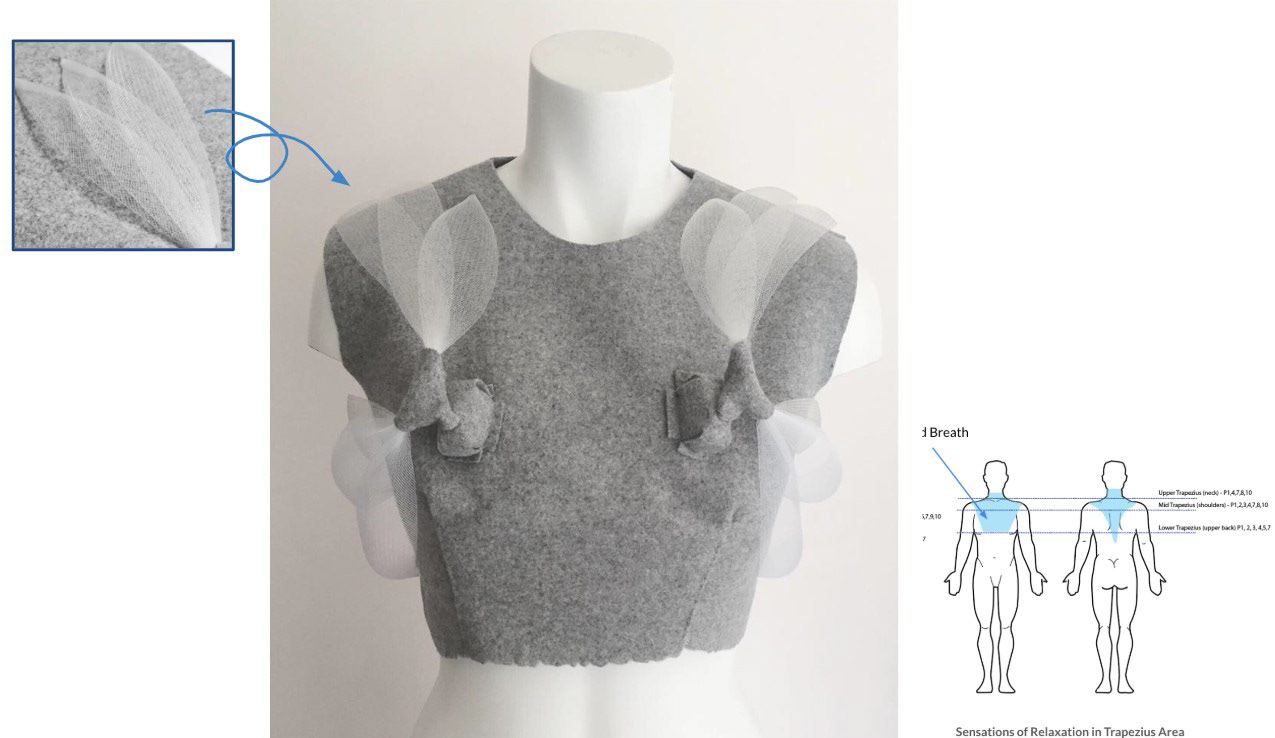
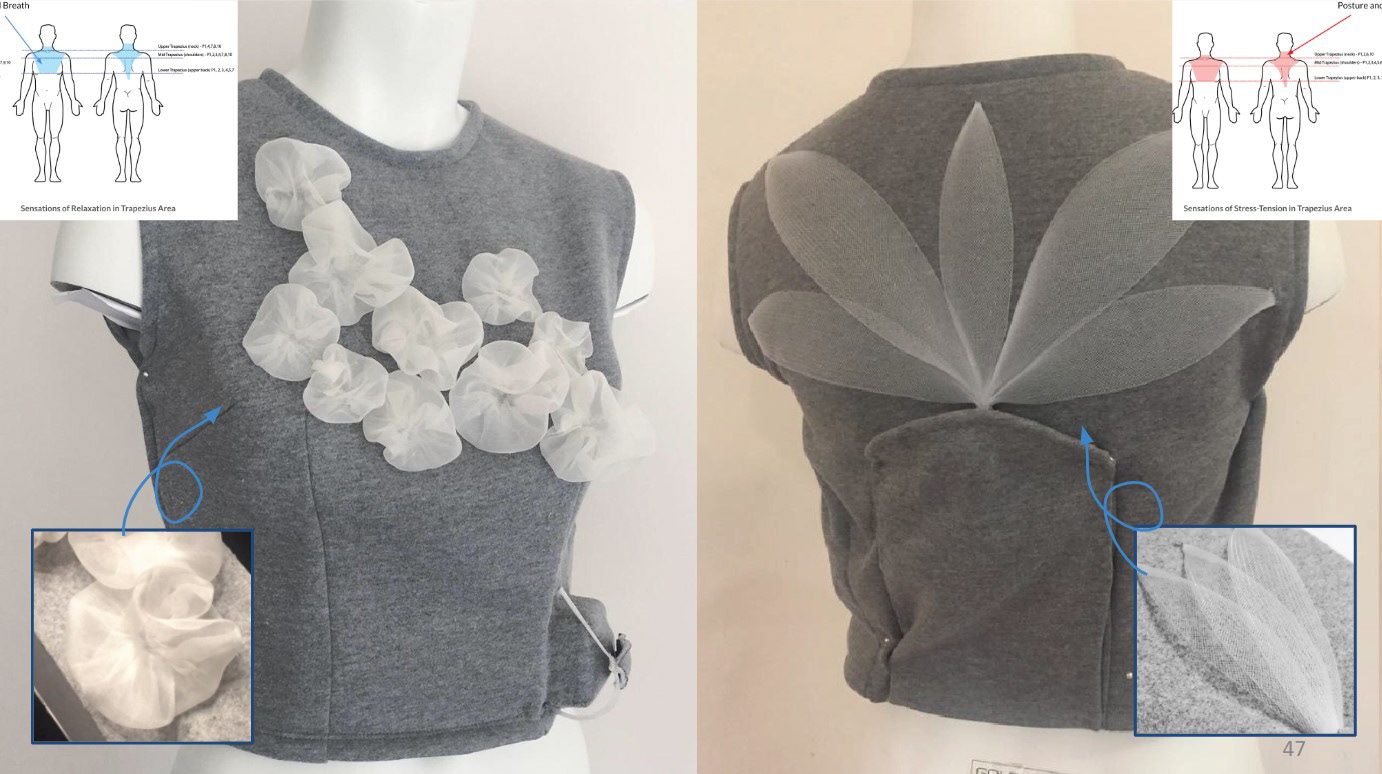

Progression of Functional Tactile Elements on Noeme 1.0
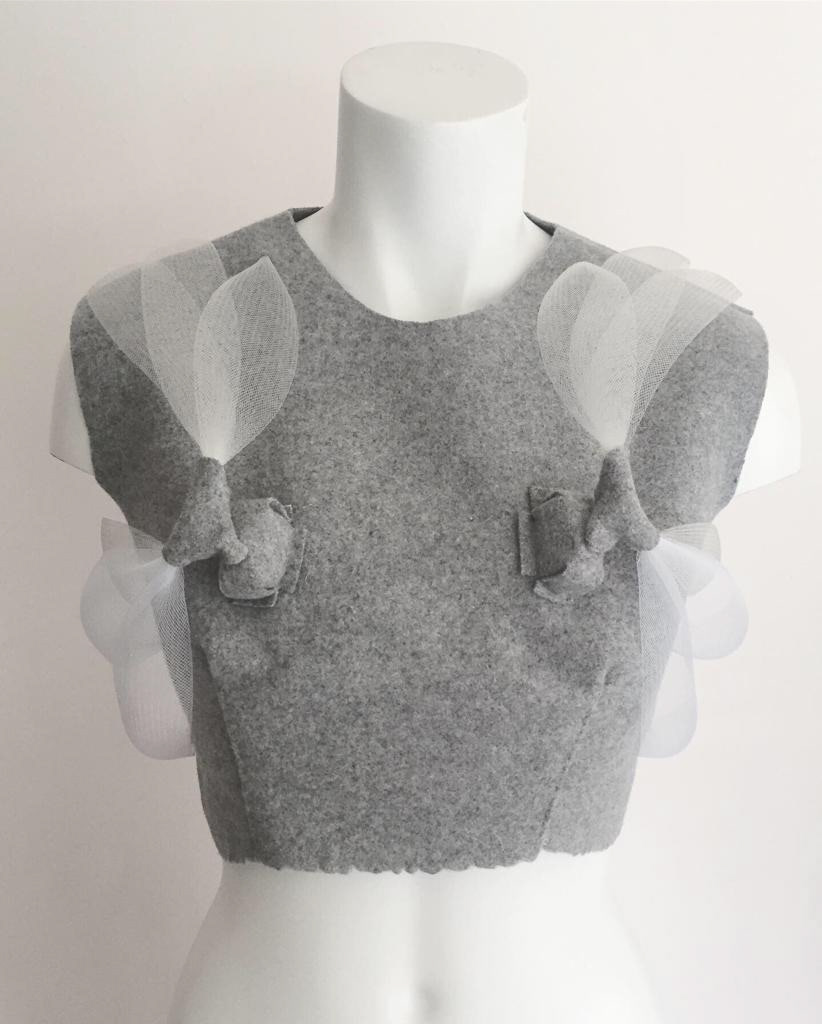
Final Completed Design of Noeme 1.0

Progression of Functional Tactile Elements on Noeme 2.0 (Front)
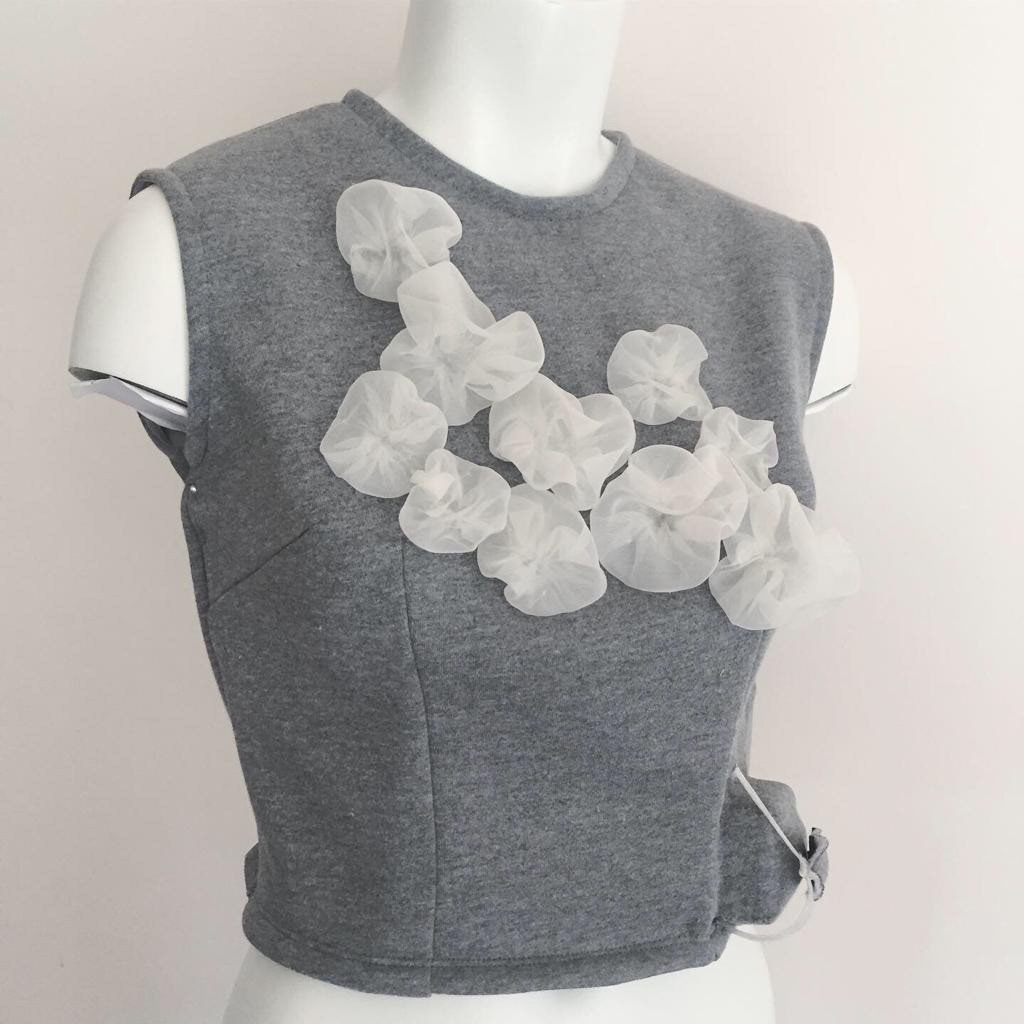
Final Design for Noeme 2.0 (Front)
DESIGN STUDY WITH NOEME 1.0 & NOEME 2.0
The design study was comprised of six participants, each consisting of an open-ended conversational interview and an experiential session with the wearable designs using the process of observation, active touch, and their in-situ reflections to bridge their own felt-sensations with the visual, tactile, and functional qualities of Noeme 1.0 & Noeme 2.0 with their felt-experiences of stress and relaxation.
Key Study Questions
Based on conducted to address two supporting questions:
(1) What functional tactile elements on a soft wearable design portray breathing and body movements, and
(2) How do compression and expansion on the upper body afford a natural mapping to felt-sensations of stress and release?
Based on conducted to address two supporting questions:
(1) What functional tactile elements on a soft wearable design portray breathing and body movements, and
(2) How do compression and expansion on the upper body afford a natural mapping to felt-sensations of stress and release?
Quiet Observation and Visual Breath Count
As a warm up, participants were asked to sit in front of Noeme 1.0 and Noeme 2.0, which were presented on the mannequin, side-by-side. The prototypes were nonfunctional at this time. Participants were prompted to take 1 minute to visually assess the prototypes while sitting in a chair. During the 1-minute quiet observation period, the design-researcher sat directly behind the participant to visually assess their chest activity to count their respiration rate. To ensure that their normal respiration rate was collected, participants were not informed until after the breath count was taken. The collection of their respiration rate provided a contextual understanding on what their ‘normal’ is during the conversational interviews.
Experiential Sessions with Noeme 1.0 & Noeme 2.0
Participants were then given up to 10 minutes to freely explore the two soft wearable designs on the mannequins. For the first 5 minutes, the kinetic feedback presented on both designs are mapped to the normal adult respiration rate of 15 breaths per minute, then mapped to a slow deep breathing rate of 6 breaths per minute.
Open-ended Conversational Interviews
After 5 minutes, with Noeme 1.0, and 2.0 still functioning, participants are asked a series of questions (see image above).
As a warm up, participants were asked to sit in front of Noeme 1.0 and Noeme 2.0, which were presented on the mannequin, side-by-side. The prototypes were nonfunctional at this time. Participants were prompted to take 1 minute to visually assess the prototypes while sitting in a chair. During the 1-minute quiet observation period, the design-researcher sat directly behind the participant to visually assess their chest activity to count their respiration rate. To ensure that their normal respiration rate was collected, participants were not informed until after the breath count was taken. The collection of their respiration rate provided a contextual understanding on what their ‘normal’ is during the conversational interviews.
Experiential Sessions with Noeme 1.0 & Noeme 2.0
Participants were then given up to 10 minutes to freely explore the two soft wearable designs on the mannequins. For the first 5 minutes, the kinetic feedback presented on both designs are mapped to the normal adult respiration rate of 15 breaths per minute, then mapped to a slow deep breathing rate of 6 breaths per minute.
Open-ended Conversational Interviews
After 5 minutes, with Noeme 1.0, and 2.0 still functioning, participants are asked a series of questions (see image above).
Throughout the entirety of the conversational interviews, participants are encouraged to actively touch and talk-aloud their experiential process, their body sensations, and emerging ideas.
Handwritten notes and audio-recordings of the interviews were transcribed, coded, and analyzed using a thematic analysis with considerations to the Somaesthetic Framework of Touch to examine the characteristics of participant's feelings and sensations based on their sense of touch and awareness of their body's movement and position (tactile-kinaesthetic experience).
Kinetic Textile Movements of Compression and Expansion on Noeme 1.0 and Noeme 2.0
Project Implications for Future Designs
Five design considerations were proposed for future explorations and iterations on soft wearable designs supporting self-regulation for relaxation and stress-release.
Five design considerations were proposed for future explorations and iterations on soft wearable designs supporting self-regulation for relaxation and stress-release.
Design Consideration #1
Applying elliptic, elongated shapes that are soft, light-weight in density with a springy, directional compression and expansion on the trapezius region can evoke a somatic-based response for stress release.
Applying elliptic, elongated shapes that are soft, light-weight in density with a springy, directional compression and expansion on the trapezius region can evoke a somatic-based response for stress release.
Textile suggestion: Polyester Horsehair (crinoline trim)
Design Consideration #2
Applying elliptic, elongated shapes that are soft, light-weight in density with a springy, up-and-out compression and expansion on the chest can support participants to develop a self-awareness to their breathing and also act as a visual guide for regulating their breathing.
Applying elliptic, elongated shapes that are soft, light-weight in density with a springy, up-and-out compression and expansion on the chest can support participants to develop a self-awareness to their breathing and also act as a visual guide for regulating their breathing.
Design Consideration #3
Applying rotund, organic shapes that are soft, light-weight in density, with a radial compression and expansion on the chest, can evoke an affective-based response for stress release.
Applying rotund, organic shapes that are soft, light-weight in density, with a radial compression and expansion on the chest, can evoke an affective-based response for stress release.
Textile suggestion: 100% Silk organza
Design Consideration #4
To maintain visual structure while achieving a smooth, comfortable tactile experience - when designing with wool felt, integrate a lining on the inside of the soft wearable design.
To maintain visual structure while achieving a smooth, comfortable tactile experience - when designing with wool felt, integrate a lining on the inside of the soft wearable design.
Textile suggestion: 2 or 3mm 100% merino wool felt, polyester lining
Design Consideration #5
The electronic mechanisms needs to be hidden as much as possible to foreground the functional tactile elements, textile insulation can help mitigate and soften the motor sounds.
The electronic mechanisms needs to be hidden as much as possible to foreground the functional tactile elements, textile insulation can help mitigate and soften the motor sounds.